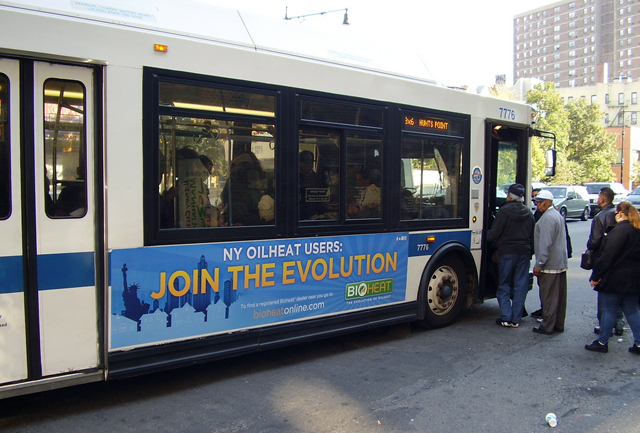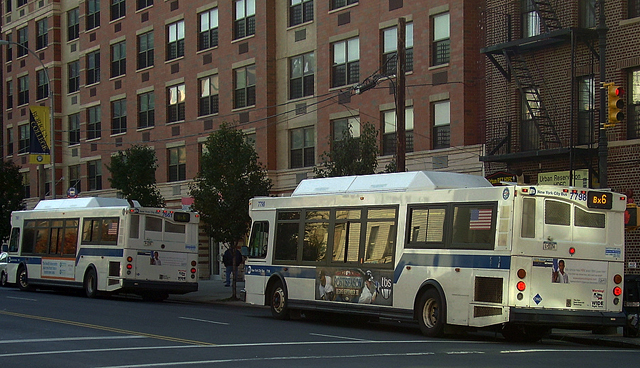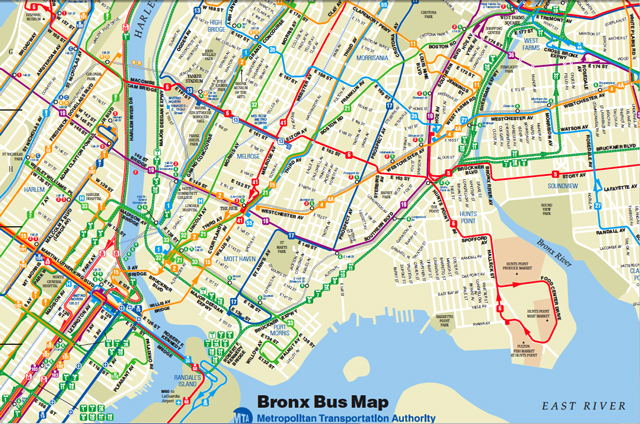Confusing Bus Riders One Cut at a Time
By Lennin Reyes
Bronx Journal Staff Writer
Back in 1994, a 5-year-old me fell in love with the New York City transit system. It began with a ride on the D train from Fordham Road to 175th Streets. I was entranced with the speed of the D, the waves of people entering and exiting smoothly, and with the gritty underground character of the stations. In the 18 years since, my fascination has blossomed into an encyclopedic knowledge of MTA workings.
In 2010, several cuts were made throughout the transit system in The Bronx. I have witnessed first-hand how these short-sighted decisions have affected local riders.
I usually take the Bx6 bus to Yankee Stadium before transferring to the D or 4 trains in order to reach Lehman College from my native Morrisania. Taking the Bx6 is not an easy task. For starters, it runs along 161st and 163rd streets, a corridor filled with five high schools, several social service programs — such as welfare, Social Security and a methadone clinic — and two courthouses.

Crowds Piling Up on the Bx6 at 161st Street and Morris Avenue
Traveling between Hunts Point and Washington Heights, the Bx6 is scheduled to run every four to six minutes during rush hours. However, it is often late due to high traffic and ridership, creating a domino effect. After waiting 10 minutes or more, buses arrive in pairs. This is known as bunching. The first bus is usually packed where elderly and disabled riders are unable to find seats.
“I often wait for two buses in order to get on,” says Deborah Quiñones, a wheelchair commuter waiting for the Bx6 at Morris Avenue. Not only do regular riders refuse to make room for me, but sometimes the lift doesn’t work.” This is a violation of the Americans with Disabilities Act, which prevents bus drivers from denying disabled riders space on a city bus regardless of crowds.
Decisions on eliminating buses are based on cost per rider and route redundancies. However, these decisions are often short-sighted since it funnels riders to high-ridership routes, such as the Bx6.
Several factors lead to the crowding on the Bx6, which had 6.61 million riders in 2010 (9th among Bronx routes). First, the presence of five high schools along the route equal loud, rebellious students during rush hours and late midday hours. And thanks to the presence of courthouses and social service programs, riders often beat the fare and add to the rowdiness. “People pick fights for the smallest of reasons, whether it be for seats, standing room, or loud kids and music,” Woodlawn resident Mary Sharpe said. “They are so desperate to reach work or school that they will find any means to get on.”
There aren’t any alternatives to the Bx6 because it’s the only crosstown bus available between 149th and 167th streets. Prior to 2008, the Bx2 ran along 165th Street en route to The Hub. After being rerouted to East 149th Street, riders bound for East 165th St shifted to other routes, such as the Bx6 and Bx32. These types of cuts are all too common in neighborhoods that have high demand for public transportation.
This confusion also occurs in Morrisania, a midwest Bronx neighborhood the Bx6 serves that has transformed from industrial to residential in recent years. Two of Morrisania’s north-south corridors, Webster and Third Avenues, lost service in recent years. The MTA cited the following cuts were done due to ridership trends. First, the Bx55 limited lost weekend service because, “more riders switched to the Bx15, which traveled further south than the Bx55,” said the MTA. This was thanks in part to weekend construction that shut down the 2, 5 and 6 lines between the Bronx and Harlem. Second, the Bx55’s midday service was cut from running every eight minutes to every 10. When Barbare Bailey of Tremont just missed the Bx55 at Fordham Plaza, she expressed frustration because she had no faith another would come along on time. The next bus would show, “whenever it feels like it,” she said.

Bunching: two or more buses arriving at the same time after a long wait
The two cuts resulted in increased reliance on the unreliable Bx15, which meanders along heavily-commercial Third Avenue and East 125th Street between Harlem and Fordham. The Bx15’s inconsistency is shown best on weekends, where the traffic along 125th Street results in delays and long wait times for Bronx riders. Riders are ultimately switching to crosstown routes to reach the subway, which leads to an overall ridership (by more than 8,000 riders) and cost per rider (by 44 cents) drop for both routes.
Like the Bx15 and Bx55 on Third Avenue, the Bx41 on Webster Avenue also had its service cut in June 2010. This was done in order to improve a route that won the Straphangers’ Campaign’s “Schleppie” Award several times. The Bx41’s northern terminal was cut from 241st Street in Wakefield to Gun Hill Road in Williamsbridge. The northern portion was replaced by the Bx39, which runs on White Plains Road. While this service cut decreased the cost per rider rate for the Bx41, its consistency has not improved. “After 7 p.m., you wait a good 35 to 60 minutes for the Bx41,” said Alonzo Williams, 48, of Bedford Park, who uses the Bx41 from Fordham. In addition, the Bx39’s cost per rider increased since it parallels the 2 train north of Bronx Park East station. This could set up a future cut where the Bx39 is cut north of Bronx Park East to encourage riders to use the subway.
Confusion after bus cuts also haunted Co-op City, where buses that once served the development’s five sections now only serve specific ones. These cuts were done to save $2.8 million and decrease the cost per rider rates for the Co-op City buses. For instance, the Bx26 went from the all-section bus to just serving sections 4-5. The worst cut, however, was the split of the Bx28 into two routes, the Bx28 and Bx38. The Bx28 runs between Fordham Center and Co-op City Section 5. The Bx38 runs between Norwood and Bay Plaza, serving Sections 1-2-3 in Co-op City. While this ended redundancy in Co-op City, those on Gun Hill Road suffered as the uneven routes of the Bx28 and Bx38 resulted in long waiting times and bunching. “The Bx28 and Bx38 run in twos, threes, and fours. At my stop on Gun Hill and Webster, three packed buses skipped my stop before an empty one came by,” said Nakia Creer, 34, of Norwood. The only upside is increased ridership onto the Bx30, which serves Sections 1, 2 and 5 of Co-op City from Boston Road.
Like Co-op City, the Southeast Bronx also had its buses restructured. To save $1 million, the MTA eliminated the Bx14, which ran between Parkchester and Country Club. This resulted in the Bx8 being rerouted from Crosby Avenue to serve Country Club and Pelham Bay via Stadium and Westchester Avenues. The Bx8 was replaced by the Bx5 on Crosby Avenue. While this brought frequent service for Country Club riders, it came at the cost of the Bx5. The added turns in Pelham Bay resulted in additional waiting times for those in Soundview and Castle Hill.
However, Southeast Bronx riders were not satisfied. Riders in Parkchester complained that without the Bx14, they would be forced to either walk to the Parkchester station or take the Bx22 to Castle Hill Avenue station. Those in the suburban area of Country Club felt they had too much service and the Bx8 now traveled on Stadium Avenue, a route that did not have bus service prior to June 2010 (the Bx14 traveled on nearby streets in a loop). Just to the south, those in the Locust Point community complained about losing direct access to the Crosby Avenue shopping strip.
As a result of these complaints, the MTA did make some changes in January 2011. The Bx8 returned to its pre-June 2010 route, where it served Crosby and Layton Avenues. Parkchester riders now had the Bx4A, a branch of the Bx4, which runs between Westchester Square and The Hub. Country Club was now served by a new route, the Bx24, which only ran to Pelham Bay Park station. While riders on Crosby/Layton avenues and in Parkchester were happy, those in Country Club were still angry that they are now served by a feeder route.
“We received half a loaf of bread,” said Councilman James Vacca, who also serves as transportation chairman to the City Council. “Those in Country Club no longer have access to the shops at Westchester Square. The elderly are forced to transfer to the 6 train and walk down the stairs at the Westchester Square station since it’s not accessible.” Making matters worse was the cost per rider between the old Bx14 and the new Bx24 ($3.40 vs. $4.27).
Citywide attention was brought to the January 2011 changes. While neighborhoods across the city continue to suffer from the bus cuts, the Southeast Bronx was able to gain some bus service back. “The MTA was financially motivated to cut service,” said Straphangers Campaign Coordinator Cate Contino. “They look at ridership levels three times a year in order to make changes.”
While the Southeast Bronx got most of their bus service restored, the only changes made for Co-op City have been splitting the QBx1 into the Q50 and Bx23, and the upcoming restoration of the Bx30 to Asch Loop, which begins in January 2012.
The cuts that affected routes across The Bronx could end up eliminating alternatives that are crucial to riders that need to reach areas not served by the subway. While they may save money, it will mean confusion and stress for riders.


Hello Mr. Reyes: I live in Inwood, Manhattan, and am retired. I am curious about the Hunts Point Market for fresh produce. It would mean that I would have to take 3 buses to and 3 buses from. Do you know if there are any plans to better connect people to Hunts Point? many thanks.